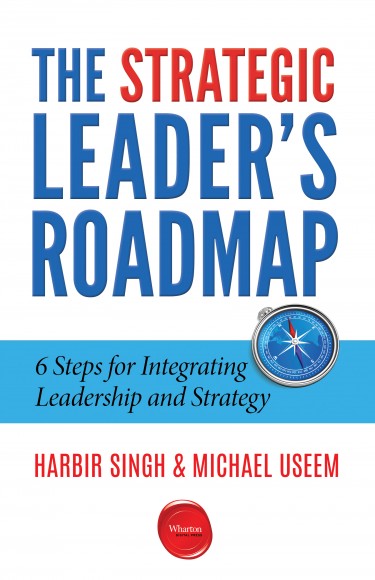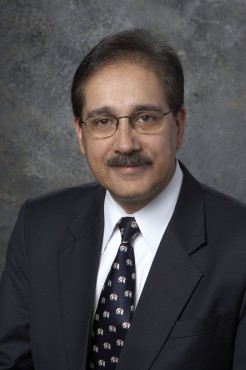Strategy and Leadership Aren’t the Same Thing – But You Do Need to Learn How to Integrate Them

Every so often, it’s a good idea to step back and reanalyze concepts we’ve grown accustomed to. When you’ve fully absorbed ideas into your vernacular and behavior, you can sometimes lose sight of the critical nuances. The ideas become automatic, touted with little self-reflection from even their most ardent proponents.
The Strategic Leader’s Roadmap: 6 Steps for Integrating Leadership and Strategy, out now from Wharton Digital Press, is a book that engages in some necessary reanalysis. The concepts of “leadership ” and “strategy” have totally saturated the business world; few are the serious professionals who don’t mention these terms with regularity. But do we really know what strategy and leadership are? And do we really know how to put these concepts to good use?
Michael Useem and Harbir Singh, Wharton management professors and the coauthors of The Strategic Leader’s Roadmap, aren’t so sure we do.
“By tradition, we tend to treat [leadership and strategy] a little separate from one another,” Useem says. “In school, for example, you might have some courses on competitive strategy and others on leadership and its development. But if you look at the best people in industries, community groups, hospitals, universities – they combine them both. They think strategically and they exercise good leadership of the people inside the organization to get from point A to point B.”
As a result, Singh, who teaches competitive strategy courses, and Useem, who teaches leadership courses, decided to collaborate on The Strategic Leader’s Roadmap, which lays out six steps one must take in order to successfully combine leadership and strategy.
Early last month, I had the chance to talk to Useem about the book. What follows is a transcript of the conversation, minimally edited for style and clarity.
Recruiter.com: So we have these two key ideas at the heart of the book: strategy and leadership. How do you define them?
Michael Useem: A way to think about strategy is to look at your own capacities with which you deliver to customers something of value. You also have to think about what your competitors are doing, and you have to be clear-minded in thinking not only about the now, but also a couple years out.
Separately, leadership is, among other things, communicating persuasively, thinking in the longer term, and deciding decisively. To go back on the main point here, the latter three capacities of leadership are obviously very important, but the payoff is especially high when they are combined with and focused around the company strategy. If you’re going off in other directions, you don’t really have a strategy. As good a leader as you may be, you’re not going to head in the direction in which you ought to be going.

RC: The book contains a few examples of leaders who demonstrate the dual qualities of strategy and leadership – people like PepsiCo’s Indra Nooyi and Cisco’s John Chambers. How did you settle on these specific people as the examples you wanted to include?
MU: We looked around for people who illustrate the point either for the better or not. Harbir Singh and I teach together, and we run programs together, and what we’ve concluded is that the way people really remember the bigger picture of keeping strategy and leadership together is if they can think of examples where it made the difference.
The main case for us is Carlos Ghosn, originally of the French automaker Renault. About 16 years ago, the Japanese automaker Nissan was not doing well. It was kind of going off a cliff at that time, in fact. So it was looking around for a strategic investor, someone who was willing to give $3 or $4 billion to Nissan to get it through this period.
After failing to find support from other auto companies, Nissan turned to Renault, which put $3.6 billion of its cash into Nissan. In doing that, Renault said, “If we’re going to do this, we want to be there inside the company helping it get back on its feet.” So Renault dispatched Carlos Ghosn, who became COO initially at Nissan. Pretty quickly, he became CEO.
While his predecessor had a good strategy to turn Nissan around and had been trying a couple of years to do so, he couldn’t make it happen – evidently because he didn’t have a full repertoire of the leadership qualities required. Ghosn came in, and because he put strategy and leadership together at the same time, he was able to turn Nissan around. He said, “Here’s what we have to do: We have to close some plants, do some tightening of our supply chains, and get some new models out.” So there was the strategy piece.
For the leadership piece, he said, “Here are the people who’re going to be on my top team, and here are the benchmarks for achieving the consolidation of suppliers by twelve months from now.” He pulled a lot of people from the middle ranks up who were high energy, thus doing the leadership thing of putting in place people who were really ready to take his ideas and make them into reality.
As a result, Ghosn became chief executive, he turned Nissan around, and now it’s one of the great carmakers. It was really looking at Ghosn’s experience that my colleague and myself really came to appreciate how important it is to combine the two, and thus we decided to include Indra Nooyi, John Chambers, and others as examples to help people not only to appreciate what we lay out conceptually, but also to see and feel what it means to be a strategic leader.
RC: The book lays out these six steps for integrating strategy and leadership. There’s one step in particular that I was hoping you could elaborate one: ensuring strategic fit. Can you explain a little more what that means and why it matters?

Coauthor Harbir Singh
MU: It’s a mistake that we often see, and I’ve committed it myself. If you’re recruiting somebody for a senior position or even a mid-level position, you tend to look for the best athlete, so to speak – somebody who is really, really good. What’s missing from that statement is that we should want somebody who is really, really good for that particular position.
What that means is, before you’re out looking for somebody, you have to get really clear about the kind of person you want for that position given the strategic imperatives. While you want a great athlete, you also want someone who really brings the leadership talent that would allow them to carry out the strategy you need for that position.
Our illustrative case for that is a succession event at the big pharma company GlaxoSmithKline. As the CEO there was stepping down, he asked that a process be gone through of looking carefully at the three good inside candidates lined up for the job. All three were good athletes, but through careful vetting of each one, the board and the top executive concluded that the dark horse was the right candidate. He was the least likely of the three and was not as good an athlete as the other two because he was younger and had not had a full range of experience at the company, but he brought a better strategic fit of leadership talent to what was needed at GlaxoSmithKline at the time. Thus, three good athletes, but the one who was picked — and he did quite well and is still the CEO – is the one whose skill set was most critical at the time.
RC: Another step that caught my attention was “decide deliberately,” which raises the interesting idea that you have to “bring the future into the present” in order to be a strategic leader. What, exactly, does that mean?
MU: It goes back to the very definition of what it means to be a strategic thinker or strategic actor. If you’re thinking strategically, you have to have a good appreciation for where you want to be in 10 years. Then, you work backward from that. You bring that future into the present to find out what you need to do.

Coauthor Michael Useem
In a sense, it means you’re thinking about all the people or stakeholders who can affect what you’re doing. If you’re working in a community group, for example, those stakeholders could be the mayor, the local police chief, the head of the parent teacher association, etc. Before you make a decisions – if you are indeed deciding deliberatively – you want to think through questions like, “If I decide to do this, how is the mayor likely to react?” Easier said than done, but that’s why leading is a difficult agenda. You have to sit down with the mayor, talk with them, and talk with the people around their office. After you’ve taken into account how these various constituents are going to think about and react to what you’re proposing, you can then make a decision.
The deficit that we all carry around – lots of behavioral psychologists and economists have documented it as well – is we know we should think longer term, but in the here and now, we often shoot from the hip. We go with our immediate intuition. Often, that serves us well, but there are moments where the use of intuition can dig a hole that you just can’t get out of later on. Thus, because our topic here is leading and being strategic, which means we’re leading for a longer term, we do need too create an ability in ourselves and among people who work with us to think about the longer term, the stakeholders, and what the competition is doing.
So, basically, it’s a fancy term for thinking holistically before you pull the trigger.
RC: And, finally, before I let you go, is there anything else you want to say to our readers?
MU: I’d like to just close on the notion that it can seem a little obvious that you need to lead and be strategic. What’s less obvious from our experience watching people in the private sector is that if you look at the people who have really changed our world – the people who have turned around a company or made a huge impact at a medical center or nonprofit – they are both strategic in thought and can actually lead people and make it happen.
What we’ve come to worry about is that we teach those topics separately, and people often think that they need one or the other if they want a job, but in our view, it’s important to get both.

